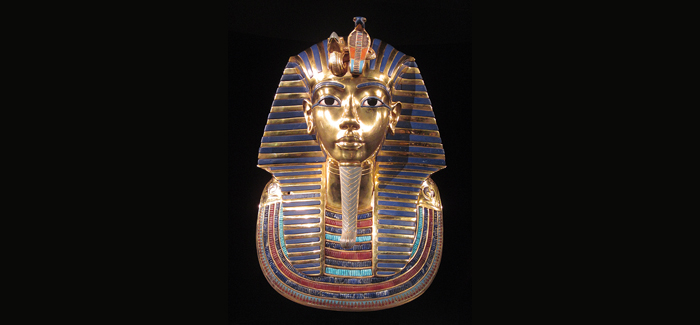Wonderful Things
“At first I could see nothing, the hot air escaping from the chamber causing the candle flame to flicker, but presently, as my eyes grew accustomed to the light, details of the room within emerged slowly from the mist, strange animals, statues, and gold – everywhere the glint of gold. For the moment – an eternity it must have seemed to the others standing by – I was struck dumb with amazement, and when Lord Carnarvon, unable to stand the suspense any longer, inquired anxiously, ‘Can you see anything?’ it was all I could do to get out the words, ‘Yes, wonderful things.’”
The words of Howard Carter as he gazed upon the ancient tomb of Tutankhamen, the discovery of the famous boy Kings burial site in 1922 becoming, almost instantaneously, the stuff of which legends and myths are made of-with a little bit of Indiana Jones sprinkled in for good measure.

Howard Carter, left, at entrance to Tut’ankhamun’s tomb
Maybe Hollywood even had Carter in mind when they cast Harrison Ford as Jones in the immensely popular films? They certainly served to give archaeology a sexed up image of derring do, dastardly foes and perpetual danger that a career served as an archaeologist in the real world could never do.
Yet maybe the exhibition to Egypt’s Valley of the Kings that he led alongside his companion and sponsor, Lord Carnarvon, was the exception to the rule?
If he is ever to be depicted as an action hero armed with trowel, map and a sense of history, then Carter’s origins were as humble as those of Tutankhamen were of bejewelled power and privilege.
He was born in London’s Kensington, the last of Samuel and Martha Carter’s eleven children. Yet neither he or his parents were Londoners. Samuel and Martha hailed from Swaffham, that ever pleasant market town that nestles, at ease and comfortable with itself, in the Breckland area of Norfolk.
Make no mistake about it, the man who made one of the most important archaeological discoveries in history is and was a man of Norfolk and we should be proud to call him one of our own.
Samuel Carter was a renowned and respected artist who specialised in painting pictures of animals who worked for the Illustrated London News from 1867 to 1889, combining that with working as a portrait painter during his time in Swaffham, a place close to his heart where he retreated to as much as possible. He was good enough to exhibit some of his paintings at the Royal Academy where they drew much public acclaim, including from the eminent Victorian art critic John Ruskin. Samuel Carter has also been credited with having created the original drawings of the great sculptures of Lions that guard Nelson’s Column in Trafalgar Square, works that were eventually created and brought to astonishing life by Sir Edwin Landseer, the artist who Samuel Carter has most been likened to.
Yet, despite accompanying his Father to some of the great stately homes of Norfolk from whom he had been summoned to paint their dogs and horses, a desire to follow in his Father’s footsteps and become an artist himself never really appealed to the young Howard Carter-although it was on one of those trips that he first became aware of the topic and study that would become his own lifelong love and obsession.
This came about as a visit to the great (and now, sadly lost) Didlington Hall, the home of the noted historian Lord Amherst, who was a great collector of Egyptian antiquities.
From the moment his eager young eyes first fell upon Amherst’s collection, any lingering thoughts that Howard Carter might have had of joining the art set himself disappeared forever. He was fascinated by them and, with his mind and imagination set in flames shared this with Lord Amherst who was able use his influence to get Howard a job at the British Museum.
Upon starting work there, Carter soon found that the skill and aptitude for art that he had inherited from his Father was in great demand and he was soon set to work making painstakingly accurate copies of the numerous Egyptian tomb drawings that were kept at the museum.
With his talent for the work and enthusiasm for the subject more than apparent, Carter was soon on a boat heading out to Egypt where he was commissioned to copy the tomb paintings at source and in-situ rather than drawings of them, this work and the opportunity it gave him to pursue his interest in ancient Egyptian archaeology coming via the Egypt Exploration Fund.
By 1897, Carter had progressed to the hugely responsible position of Inspector for the Service of Antiquities whilst also working alongside the man who was his mentor, Flinders Petrie who was, at the time, the most famous archaeologist in Egypt. Three years later he was appointed as the Inspector of Monuments for Upper Egypt and Nubia-a colossal area of land that included numerous sites of great importance-as well as, of course, many yet to be discovered.
The knowledge that there were wonders out there, hidden from human eyes under all that sand and rock, unseen for thousands of years drive Carter to seek both funding and patronage to set about finding it which is how his famous partnership with Lord Carnarvon came about. Carter had the expertise whilst Carnarvon had the money-and they both had the passion for exploration.
It was inevitable that they would indeed go onto find “wonderful things.”
Carnarvon readily funded Carter’s explorations for several years but, by 1922, with the Valley of the Kings thought to be exhausted and with no more secrets to hold, Carnarvon motioned that the work there should cease, a thought that was shared by several senior archaeologists also working out there at the time.
Perhaps this is when Carter showed some of that spirit and sense of adventure portrayed by Indiana Jones himself? For, despite Carnarvon’s misgivings and readiness to quit the project, Carter was so determined to keep looking that he offered to fund that excavation himself. This conviction so impressed Carnarvon that he agreed to act as his benefactor for another year.
Thus, on November 1st 1922, Carter, along with 100 men in his employ began the work of clearing some rubble around where he was convinced an undiscovered (and therefore un-looted) tomb lay.
His conviction was splendidly rewarded when, with Carnarvon in close attendance, he discovered the hither-to lost tomb of Tutankhamen, describing it as, “the day of days, the most wonderful I have ever lived through, and certainly the one whose like I can never hope to see again”.
He hadn’t just made history. He had become part of history himself.
Not bad for lad from Swaffham who might have thought he’d have ended up painting the lapdogs of the rich and privileged for a living.
Edward Couzens-Lake for Iceni Magazine.
Follow Ed on Twitter: @EdCouzensLake









